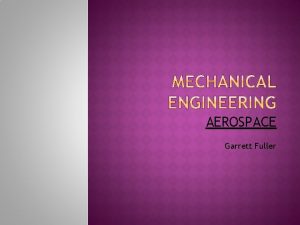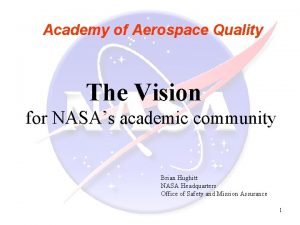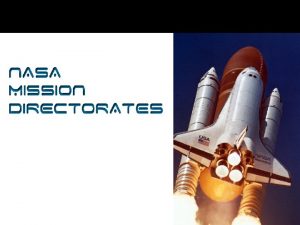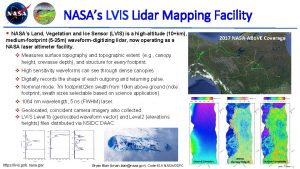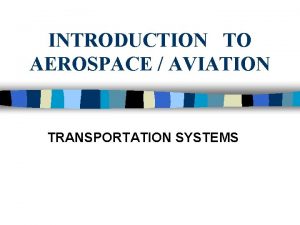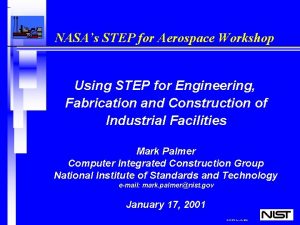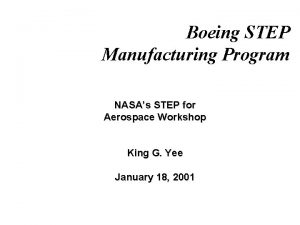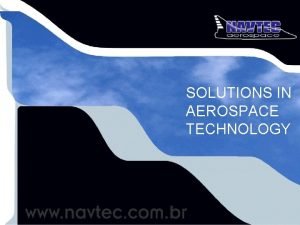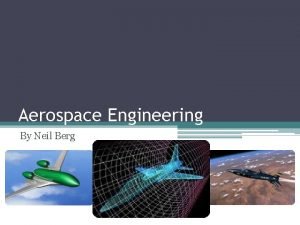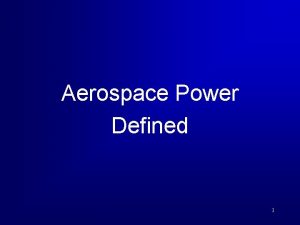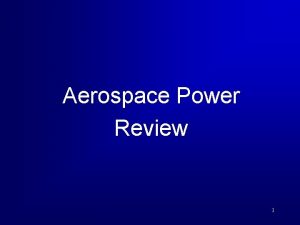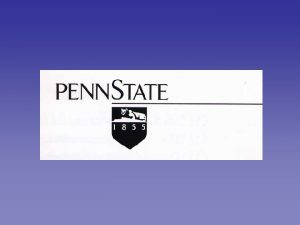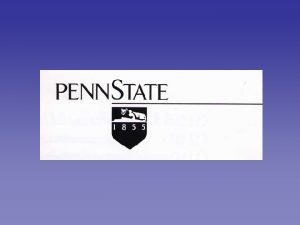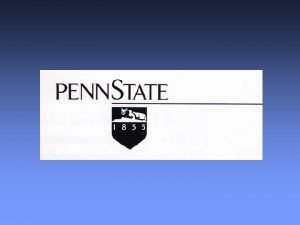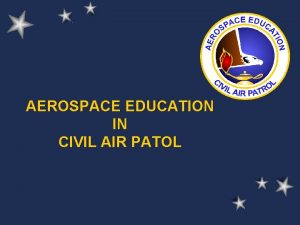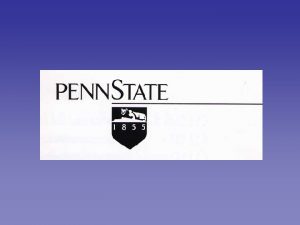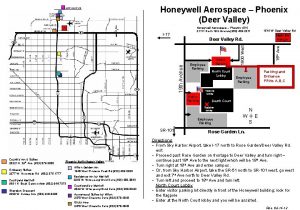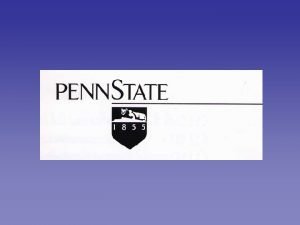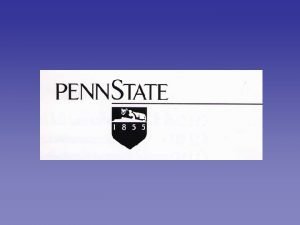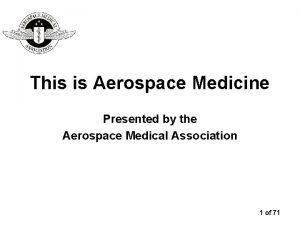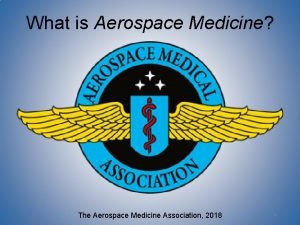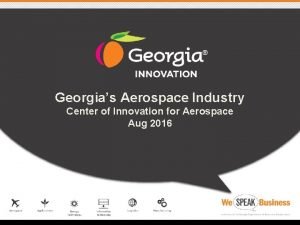NASAs Vision for Aerospace Transportation Home Home Meeting























- Slides: 23

NASA’s Vision for Aerospace Transportation Home & Home Meeting Chicago O’Hare / United Airlines August 29, 2000 Sam Venneri Associate Administrator for Aerospace Technology

Shifting Marketplace U. S. Sale of Aircraft Engines and Parts 1984 1998 -2008 average Military 22% Military 11% Civil 78% Civil 44% Military 56% $9. 0 B* Civil 89% $12. 8 B* $14. 7 B* *current year dollars Sources: Aerospace Industries Association, Aerospace Facts & Figures 1999 -2000, online Aviation & Aerospace Almanac 1999, Mc. Graw Hill International Gas Turbine Forecast, Forecast International, 1999

Declining Market Share W OR LD SHARES 100% 90% 80% 70% 60% 50% 40% 30% 20% USA EU Japan Canada 10% 0% 1985 1986 1987 1988 1989 1990 1991 1992 1993 1994 1995 1996 1997 1998 Source: Commission of the European Communities, Trading Position and Figures , 1997 and AECMA for 1996 to 1998.

Growth and Constraints 300 Revenue Ton Miles (RTM) 250 Revenue Passenger Miles (RPM) 200 150 100 Gross Domestic Product (GDP) 50 32 Number of Airports Indexed Value (1993=100) 350 Demand for Transportation US Airports Exceeding 20, 000 Hrs Delay Annually 31 30 29 28 27 26 25 1997 0 1988 1990 1992 1994 1996 1998 2000 2002 2004 2006 2008 2010 Source: FAA Aviation Forecasts, selected volumes Source: LMI, 1999 2007

Aerospace Technology Enterprise Goals & Objectives Mobility Revolutionizing Aviation Reduce Accident Rates Increase System Throughput Reduce Noise Advancing Space Transportation Reduce mission & crew loss Reduce Cost Reduce Mission Time Pioneering Technology Innovation Engineering Innovation Reduce Emissions Reduce intercity & transcontinental travel time

NASA Technology Partnerships & Relationships CH E T S & MENT N P O LOP E V DE TECHNOLOGY READINESS 9 FAA, Do. D & Industry Implement 8 7 6 5 4 NASA Aero-Space Technology IMPLEMENTATION PRODUCT S REQUIREMENT DEFINITION Partnering Committees 3 2 1 CONCEPT EXPLORATION CONCEPT DEVELOPMENT PROTOTYPE FULL-SCALE DEVELOPMENT IMPLEMENTATION PRODUCT DEVELOPMENT CYCLE

Hub and Spoke Congestion

Aviation Systems Capacity Program Short-Haul Civil Tilt-Rotor (SHCT) Develop the most critical technologies to enable a civil tilt-rotor: • reducing perceived noise 12 d. B • enabling safe terminal area operations • enabling OEI operation Terminal Area Productivity (TAP) Safely achieve clear-weather airport capacity in instrumentweather conditions: • increasingle runway throughput 12 to 15% • reducing lateral spacing below 3400 feet on parallel runways Advanced Air Transportation Technologies (AATT) In alliance with the FAA, enable next generation of increases in capacity, flexibility and efficiency, while maintaining safety, of aircraft operations within the US and global airspace system: • increasing terminal throughput 40% • increasing enroute throughput 20%

Accomplishments • Capability that has been developed, demonstrated and in limited operation – – Passive Final Approach and Spacing Tool (p. FAST) Traffic Management Advisor (TMA) Surface Movement Advisor (SMA) Collaborative Arrival and Spacing Tool (CAST) • Capability that has been developed and demonstrated – Airborne Information for Lateral Spacing (AILS) – Advanced Vortex Spacing System (AVOSS)

5400 US Airports

Small Aircraft Transportation System

Digital Airspace Infrastructure • A client-server-based architecture will provide information services on an “Airborne Internet” to support collaborative air traffic management. Aircraft and landing facilities will be interconnected nodes in a high-speed digital communications network providing instant identification and information services on demand with seamless linking to the global transportation system. • “Smart Landing Facilities” will provide automation-enabled separation and sequencing in nontowered, non-radar, non-hub terminal • “Simultaneous Non-Interfering Operations” will airspace. enable hub & spoke airport throughput to be increased developing the infrastructure capability to use stub runways, taxiways, & vertiports instead of conventional runway under adverse weather conditions.

Advanced Subsonic Transportation

Quiet Aircraft Technology Program Airframe Noise Reduction Propulsion/Airframe Aeroacoustics Wind Community Noise Impact Advanced Operations Jet Noise Reduction Broadband Fan Noise Reduction

Advanced High-Speed Transportation

Safer Transportation

Aviation Safety Program Weather Accident Prevention Develops technologies to reduce the fatal accident rate induced by weather hazards System-Wide Accident Prevention Addresses aviation safety issues associated with human error and procedural non-compliance Single Aircraft Accident Prevention Develops technologies for in-flight applications with an initial emphasis on Controlled Flight Into Terrain, Loss of Control in Flight, and Runway Incursion type accidents. Synthetic Vision Accident Mitigation Provides technology to provide commercial and general aviation pilots with clear out-the-window views regardless of the actual visibility conditions Develops technology to increase the human survival rate in survivable accidents and to prevent in-flight fires

Future Directions in Aviation Operations Research • Expanded partnerships - airlines and airports • Increased investment in support of Free Flight Phase 1, 2 and 3 – Extend automation tools into more complex airspace – New automation tools – High-assurance software • Renewed investment in long-term aviation operations research – Explore new, high-capacity air traffic management architectures and supporting technologies – Develop large-scale, non-linear, human-in-the-loop research simulation capability for the U. S. airspace system

Integrated Aerospace Transportation System

Aerospace Vision and Challenges

R&T Base Programs • Vehicle Systems Technology (VST) : Advanced airframe and spaceframe technology concepts and methods. • Information Technology (IT): Computational tools and integrated systems for the design and manufacture of flight vehicles and systems. • Operation Systems (OS): Air traffic management systems; relevant cockpit system; , operational human factors; weather and hazardous environment characterization, detection, and avoidance systems; and communications, navigation, and surveillance. • Propulsion and Power (P&P): Breakthrough propulsion technologies through high-risk, highpayoff R&T development and multidisciplinary air-breathing aerospace propulsion technologies. • Flight Research (FR): Remotely piloted and autonomous air vehicles, advanced vehicle system concepts, transportation related technologies, and tools and test techniques. • Rotorcraft (RC): Improved flight safety, reduction of noise for passengers and the community, design tools for reduced design-cycle time and reduced manufacturing costs of rotorcraft. • Space Transfer and Launch Technology (STLT): Pioneers the identification, development, verification, transfer, and application of high-payoff space transportation technologies. Provides a foundation for the broad range of technologies needed for a steady influx of concepts.

Aero Focused Programs • • High Performance Computing and Communications (HPCC) : Accelerates the development, application, and transfer of high performance computing capabilities and computer communication technologies to meet the engineering and science needs of the U. S. aerospace, Earth and space science, and spaceborne research and education communities and accelerates the distribution of technologies to the American public. Aviation System Capacity (ASC): Enables safe increases in the capacity of major U. S. and international airports, through enabling improvements to, and modernization of, the Air Traffic Management system, as well as the introduction of new vehicle classes whose operation can take advantage of the improved, modern Air Traffic Management system. Aviation Safety Program (Av. SP): Develops and demonstrates technologies that contribute to a reduction in aviation accident and fatality rates by focusing on Accident Prevention, Aviation System Monitoring and Modeling, Accident Mitigation, and Synthetic Vision. Ultra Efficient Engine Technology (UEET): Addresses local air quality concerns by developing technologies to reduce nitrogen oxide (NOx) emissions and addresses potential ozone depletion concerns by demonstrating combustor technologies to enable no discernible aircraft impact on the ozone layer during cruise operation.

Total System Delays per month (thousands) Total US Air Traffic Delays (1997 -1999) 50 45 40 35 30 25 20 15 10 5 0 SOURCE: FAA OPSNET ATC-200 99 98 97
 Types of meeting
Types of meeting Today meeting or today's meeting
Today meeting or today's meeting Proposal kickoff meeting agenda
Proposal kickoff meeting agenda What is meeting and types of meeting
What is meeting and types of meeting Human vision vs computer vision
Human vision vs computer vision Tack för att ni har lyssnat
Tack för att ni har lyssnat Borra hål för knoppar
Borra hål för knoppar Anatomi organ reproduksi
Anatomi organ reproduksi Smärtskolan kunskap för livet
Smärtskolan kunskap för livet Bris för vuxna
Bris för vuxna Jiddisch
Jiddisch Typiska novell drag
Typiska novell drag Trög för kemist
Trög för kemist För och nackdelar med firo
För och nackdelar med firo Humanitr
Humanitr Toppslätskivling effekt
Toppslätskivling effekt Redogör för vad psykologi är
Redogör för vad psykologi är En lathund för arbete med kontinuitetshantering
En lathund för arbete med kontinuitetshantering Bra mat för unga idrottare
Bra mat för unga idrottare Gumman cirkel
Gumman cirkel Claes martinsson
Claes martinsson Ledarskapsteorier
Ledarskapsteorier Offentlig förvaltning
Offentlig förvaltning Plagg i rom
Plagg i rom
























